

As your child grows into adolescence, you may find it difficult to maintain a close relationship with them and provide guidance as they gain independence and experience social and emotional changes. To navigate through this new parenting journey, you can apply the principles of reinforcement and punishment to influence your child’s behaviour.
Read on to understand more about the changing needs of your teenage children and how you can implement reinforcement and punishment to manage their behaviours.
The Psychology of Adolescence - The Science of Adolescent Risk-Taking: Workshop Report - NCBI Bookshelf. Development of Parent–Adolescent Relationships: Conflict Interactions as a Mechanism of Change. What Is Operant Conditioning and How Does It Work? Operant conditioning, sometimes referred to as instrumental conditioning, is a method of learning that employs rewards and punishments for behavior.
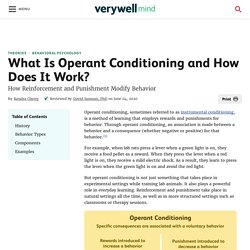
Through operant conditioning, an association is made between a behavior and a consequence (whether negative or positive) for that behavior.1 For example, when lab rats press a lever when a green light is on, they receive a food pellet as a reward. Operant Conditioning (B.F. Skinner) The theory of B.F.
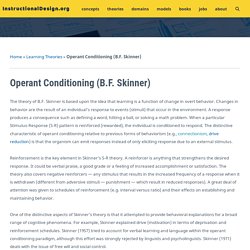
Skinner is based upon the idea that learning is a function of change in overt behavior. Changes in behavior are the result of an individual’s response to events (stimuli) that occur in the environment. A response produces a consequence such as defining a word, hitting a ball, or solving a math problem. [video] Operant Conditioning. [key concepts] Reinforcement. Reinforcement Reinforcement is defined as a consequence that follows an operant response that increase (or attempts to increase) the likelihood of that response occurring in the future.
![[key concepts] Reinforcement](http://cdn.pearltrees.com/s/pic/th/reinforcement-psychological-182730848)
Positive Reinforcement In an attempt to increase the likelihood of a behavior occurring in the future, an operant response is followed by the presentation of an appetitive stimulus. [key concepts] Punishment. Punishment is defined as a consequence that follows an operant response that decreases (or attempts to decrease) the likelihood of that response occurring in the future.
![[key concepts] Punishment](http://cdn.pearltrees.com/s/pic/th/comparative-psychological-240250714)
Positive Punishment In an attempt to decrease the likelihood of a behavior occurring in the future, an operant response is followed by the presentation of an aversive stimulus. This is positive punishment. If you stroke a cat's fur in a manner that the cat finds unpleasant, the cat may attempt to bite you. Therefore, the presentation of the cat's bite will act as a positive punisher and decrease the likelihood that you will stroke the cat in that same manner in the future.
Summary of Key Ideas. Positive Reinforcement in Psychology (Definition + 5 Examples) If you read our earlier piece on positive punishment, you know that there are different methods of teaching and instilling good habits and behaviors.
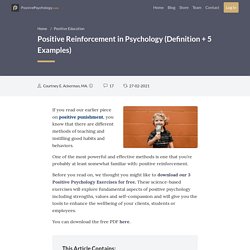
One of the most powerful and effective methods is one that you’re probably at least somewhat familiar with: positive reinforcement. Before you read on, we thought you might like to download our 3 Positive Psychology Exercises for free. Positive Reinforcement for Adolescents. By the time children have reached adolescence, their responses are often ingrained, but parental actions can still positively affect adolescent behavior. Since adolescents are struggling to develop their personal identity and are concerned about their body image, parental support is crucial to help positively frame experiences as learning opportunities.
Positive reinforcement remains a powerful teaching tool during these formative years, and we encourage parents to take time to contemplate the ways they can help adolescents mature and become self-reliant. Reinforce mature decisions by allowing increased privileges when adolescent demonstrates increased responsibility. For instance, an adolescent who consistently demonstrates the ability to come home at the requested time might be allowed a later curfew - whereas an adolescent who has not completed requested chores will not be allowed to leave home that evening.Express pleasure at positive adolescent behavior.
How to Reward Your Teen for Good Behavior. Teenagers are young adults who are trying to learn the ways of the world.
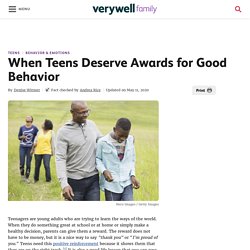
When they do something great at school or at home or simply make a healthy decision, parents can give them a reward. The reward does not have to be money, but it is a nice way to say "thank you" or "I'm proud of you. " Summary of Positive Reinforcement for Adolescents.
Negative Reinforcement and Operant Conditioning. Negative reinforcement is a term described by B.
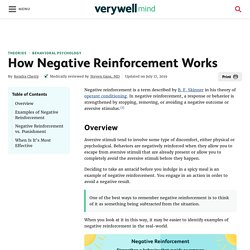
F. Skinner in his theory of operant conditioning. In negative reinforcement, a response or behavior is strengthened by stopping, removing, or avoiding a negative outcome or aversive stimulus.1 Overview. Negative Reinforcement: What Is It and How Does It Work? What is negative reinforcement?

Negative reinforcement is a method that can be used to help teach specific behaviors. With negative reinforcement, something uncomfortable or otherwise unpleasant is taken away in response to a stimulus. Summary of Negative Reinforcement for Adolescents. How Reinforcement Schedules Work. Operant conditioning is a learning process in which new behaviors are acquired and modified through their association with consequences.
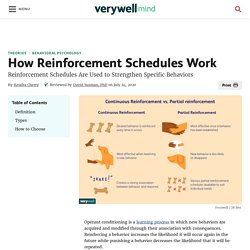
Reinforcing a behavior increases the likelihood it will occur again in the future while punishing a behavior decreases the likelihood that it will be repeated. In operant conditioning, schedules of reinforcement are an important component of the learning process. When and how often we reinforce a behavior can have a dramatic impact on the strength and rate of the response. Schedule of Reinforcement. Schedules Of Reinforcement - Psychology. Schedules of reinforcement can affect the results of operant conditioning, which is frequently used in everyday life such as in the classroom and in parenting.

Let’s examine the common types of schedule and their applications. Schedules Of Reinforcement Operant conditioning is the procedure of learning through association to increase or decrease voluntary behavior using reinforcement or punishment. Schedules of reinforcement are the rules that control the timing and frequency of reinforcer delivery to increase the likelihood a target behavior will happen again, strengthen or continue.
A schedule of reinforcement is a contingency schedule. Introduction to Psychology. Learning Objectives Distinguish between reinforcement schedules Remember, the best way to teach a person or animal a behavior is to use positive reinforcement. Key Ideas. 12 Examples of Positive Punishment & Negative Reinforcement. You might be thinking that “positive punishment” sounds like an oxymoron, after all, how can punishment be positive? Not many people “like” punishment, right? The disconnect in understanding this concept comes from the usage of the word “positive;” here at PositivePsychology.com, we generally use the term “positive” to refer to things that are inherently good, things that are life-giving, and things that promote thriving and flourishing.
The concept of positive punishment comes from a very different era and a very different perspective on psychology; namely, the 1930s and behaviorism. So, what actually is positive punishment and how does it relate to parenting, teaching, and even the workplace? Positive Punishment and Operant Conditioning. Positive punishment is a concept used in B.F. Skinner's theory of operant conditioning. How exactly does the positive punishment process work? The goal of any type of punishment is to decrease the behavior that it follows. In the case of positive punishment, it involves presenting an unfavorable outcome or event following an undesirable behavior. Real-Life Examples of Positive Punishment.
“Positive” and “punishment” seem like two words that you wouldn’t use together. However, positive punishment will make complete sense once you learn the definition and explore some examples of positive punishment. Review how positive punishment is different from negative punishment and which is more effective. Understanding Positive Punishment “Positive punishment” might seem like an oxymoron. However, if you expand your thinking beyond positive to mean something “good” to positive meaning to add something, then a positive punishment makes a lot of sense. Positive Punishment Guidelines. Summary of Positive Punishment for Adolescents. How Negative Punishment Works. Discipline for Teens: Strategies and Challenges. Teen Bad Behavior & Discipline Plans - Promoting Healthy Growth Ages 15 - 18.
Summary of Negative Punishment for Adolescents. Untitled. How to Go From a Nagging Parent to a Master Motivator. Psychological Services of Pendleton. Positive parenting predicts the development of adolescent brain structure: A longitudinal study.